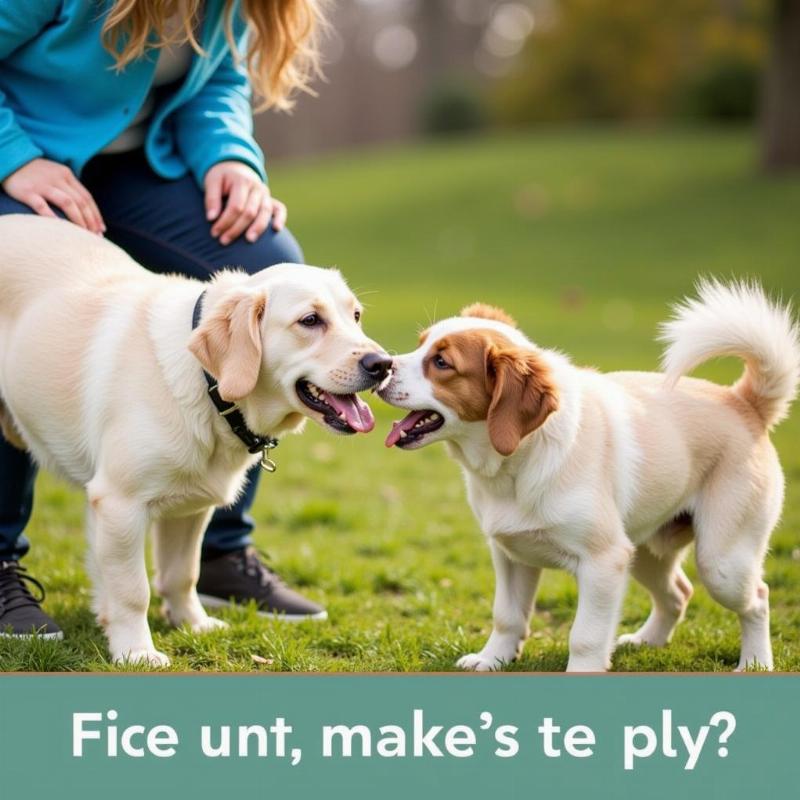A dog with another dog in its neck can be a cause for concern, especially for new dog owners. While this often looks aggressive, it’s usually a normal part of dog play. However, it’s crucial to understand the difference between playful interaction and potential aggression to ensure the safety of all dogs involved. This article will delve into the nuances of dog play, how to recognize warning signs, and offer practical tips for preventing injuries.
Decoding Canine Play: Is it Play or Aggression?
It’s natural to be alarmed when you see a dog with another dog in its neck. However, this neck-biting behavior is often a key component of canine play. Dogs use it to establish dominance, communicate, and even just have fun. Think of it as their version of a playful wrestle. Key indicators of playful interaction include: relaxed body language, playful bowing, wagging tails, and open mouths with relaxed panting. They’ll often take turns “winning” the wrestle, showing that it’s a balanced interaction. If you’re considering a new shock collar for your large dog, see our guide on waterproof shock collar for large dogs.
Recognizing the Warning Signs: When Play Turns Sour
While play is essential for dogs, it’s vital to be aware of when things might escalate. A dog with another dog in its neck could signal aggression if accompanied by: stiff body language, bared teeth, growling, snarling, pinned-back ears, and a tucked tail. These are clear signs that the interaction is no longer playful and needs intervention. Pay close attention to the dogs’ vocalizations and body language. A high-pitched yelp can indicate that one dog is uncomfortable or hurt.
Preventing Injuries During Play: Proactive Steps for Dog Owners
 Preventing dog bites during play
Preventing dog bites during play
As a responsible pet owner, it’s your job to ensure safe play sessions for your dog. Supervise play, especially between dogs of different sizes or temperaments. Intervene immediately if you observe any warning signs of aggression. Provide plenty of toys to redirect their energy and focus. Consistent training and socialization are also crucial in teaching your dog appropriate play behavior. Regular exercise can help reduce pent-up energy that might otherwise contribute to overly boisterous play. For tips on feeding your dog raw chicken necks, visit our article on raw chicken necks for dogs.
Ensuring Safe and Healthy Interactions
Understanding canine communication is paramount to fostering positive interactions. A dog with another dog in its neck doesn’t automatically indicate a problem. By learning to decipher their subtle cues and providing a safe, supervised environment, you can help ensure that play remains a healthy and enriching experience for all dogs involved.
What to Do if a Fight Breaks Out
If a play session escalates into a fight, it’s important to act quickly and calmly. Never try to physically separate fighting dogs with your hands as you risk serious injury. Instead, try using a loud noise to startle them, spraying them with water, or using a blanket or towel to create a barrier between them. Once separated, immediately check both dogs for injuries and consult a veterinarian if necessary.
Conclusion: Promoting Healthy Dog Play
Understanding the dynamics of dog play, recognizing warning signs, and implementing preventative measures are essential for responsible dog ownership. A dog with another dog in its neck is often a normal part of play. However, vigilance and understanding are key to distinguishing between play and aggression, ensuring safe and enjoyable interactions for all dogs involved. By following the guidelines outlined in this article, you can help your furry friend enjoy healthy and enriching play experiences. Looking for matching accessories for you and your furry friend? Check out our collection of matching scarves for dog and owner.
FAQ:
-
Why do dogs bite each other’s necks during play? Neck biting is a common play behavior in dogs, often used to communicate, establish dominance, and engage in playful wrestling.
-
How can I tell the difference between play biting and aggression? Look for relaxed body language, wagging tails, and playful bowing during play. Aggression is signaled by stiff posture, bared teeth, growling, and a tucked tail.
-
What should I do if my dog’s play becomes too rough? Intervene immediately. Separate the dogs and redirect their attention with toys or a change of activity.
-
Is it okay to let dogs play unsupervised? Unsupervised play can be risky, especially with dogs of different sizes or temperaments. Supervision allows you to intervene if necessary.
-
What should I do if a dog fight breaks out? Never use your hands to separate fighting dogs. Use a loud noise, water, or a barrier like a blanket. Consult a vet if there are injuries.
-
How can I prevent my dog from playing too roughly? Consistent training and socialization are key. Teach your dog appropriate play behavior and provide plenty of exercise.
-
Are there specific breeds prone to rough play? Some breeds have higher energy levels and may engage in more boisterous play, but any dog can play roughly.
Beautdogs.us is your premier resource for all things dog-related in the US. We offer expert advice on dog care, breed information, product recommendations, and much more. Whether you’re a seasoned dog owner or just starting your journey, Beautdogs.us is your trusted source for comprehensive and engaging information. For more information, contact us at [email protected] or call us at +1 501-555-7529. Visit Beautdogs.us today!